![]()
![]()
![]()
Use LEFT and RIGHT arrow keys to navigate between flashcards;
Use UP and DOWN arrow keys to flip the card;
H to show hint;
A reads text to speech;
54 Cards in this Set
- Front
- Back
|
Define the equine digit.
|
consists of the foot and pastern and includes the phalanges and associated structures
|
|
|
Define the equine foot
|
Foot consists of epidermal hoof and all it encloses: connective tissue corium (dermis), digital cushion, distal phalanx, cartilages of the distal phalanx, distal interphalangeal joint, distal extremity of middle phalanx, distal sesamoid (navicular) bone, podotrochlear (navicular) bursa, ligaments, tendons of insertion of common digital extensor and deep digital flexor muscles, blood vessels and nerves
|
|
|
What is the equine dermis of the hoof referred to as?
|
Corium
|
|
|
What term is the equine foot synonymous with?
|
hoof.
|
|
|
What are the fascial ligaments of the equine and ruminant digit?
|

A) Palmar annular ligament, B) proximal digital annular ligament, C) distal digital annular ligament
|
|
|
At what level is the palmar annular ligament of the equine digit? What does it course between? What does it bind down?
|

At the level of the fetlock (A)
Courses between the abaxial borders of the proximal sesamoids Binds down the digital flexor tendons in the sesamoid groove |
|
|
What does the proximal digital annular ligament of the equine foot cover and course between?
|

(B)
Covers the superficial digital flexor tendon Attaches to the sides of the proximal phalanx Binds down the digital flexor tendons |
|
|
What does the distal digital annular ligament of the equine foot cover and course between?
|

(c)
Covers the terminal expansion of the deep digital flexor tendon Attaches to the medial and lateral borders of the proximal phalanx |
|
|
What is another name for the interosseus ligament in the horse?
|
Suspensory ligament.
KNOW FOREVER! |
|
|
What is a splint in the horse?
|
There are splint bones, but a splint refers to fraying of the interosseus ligament.
|
|
|
Is the fetlock normally in an overextended or flexed position? What holds it there?
|
Overextended.
Held in place by the suspensory apparatus. Composed of: Interosseus (proximal sesamoidean ligament of the proximal sesamoids, suspensory ligament) Proximal sesamoid bones Intersesamoidean (palmar) ligament Distal sesamoidean ligaments of the proximal sesamoids |
|
|
What holds the proximal sesamoids in place in the equine?
|
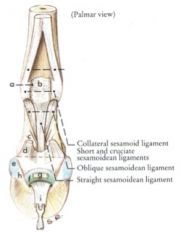
Intersesamoidean (palmar) ligament
|
|
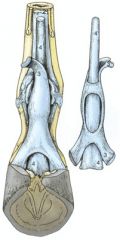
Name these structures.
|

1. Splint bones
2. Interosseus 3. Superficial digital flexor tendon 4. Deep digital flexor tendon |
|
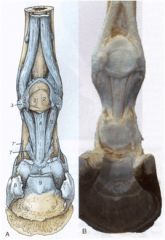
What is 4 and 5?
What is the third distal sesamoidean ligaments of the proximal sesamoids? What are their function? |

4 - Straight (Superficial, Y) ligament
From the base of the proximal sesamoids to the proximal end of the middle phalanx 5 - Oblique (Middle, V) ligament From the base of the proximal sesamoids to a triangular rough area on the proximal phalanx The third one is: Cruciate (Deep, X) ligament From the base of the proximal sesamoids to the proximal part of the proximal phalanx (opposite side) Function is to support the fetlock? |
|

What are 7 and 7'?
What is the other ligament associated with the proximal interphalangeal joint (pastern) of the equine digit? |

Palmar ligaments (7, 7’)
Central pair and lateral and medial bands From middle of proximal phalanx to proximal end of middle phalanx Collateral ligaments From distal end of proximal phalanx to proximal end of middle phalanx |
|
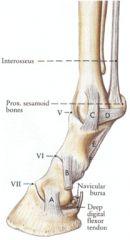
What are the ligaments associated with the joints of the coffin (distal interphalangeal) joint?
|

Collateral ligaments (A)
From distal part of middle phalanx to each side of extensor process of distal phalanx |
|
|
What else is the navicular bone known as?
|
Distal sesamoid bone
KNOW FOREVER |
|
|
What phalanges are the navicular bone in contact with in the horse?
|
Distal sesamoid (navicular) bone is in contact with the middle and distal phalanges
|
|
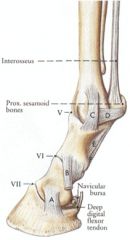
What are C and D of the equine digit? (these are ligaments of the fetlock metacarpophalangeal joint)
|

Collateral ligaments (C)
Superficial layer – From distal metacarpal III to proximal phalanx Deep layer – from distal metacarpal III to abaxial surface of sesamoid and proximal end of proximal phalanx Collateral sesamoidean ligaments (D) From abaxial surface of sesamoid to distal end of metacarpal III and proximal end of proximal phalanx |
|

What is the difference in the collateral cartilages of the hoof by age?
|

Hyaline cartilage in young horses and fibrocartilage in middle-aged horses
In older horses, the cartilages tend to ossify, forming “sidebones” |
|
|
Where does the interosseus insert?
|
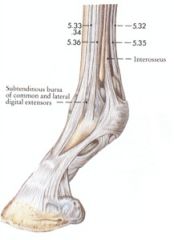
Interosseus divides proximal to the fetlock joint and inserts on the abaxial surface of the proximal sesamoids
Sends extensor branches to join the common digital extensor tendon |
|
|
What is the coronet of the horse hoof?
|
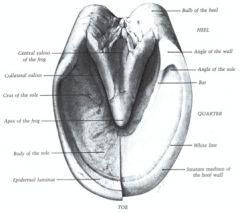
Junction between skin and hoof
|
|
|
What is the periople of the hoof?
|
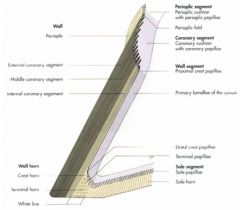
Just below the coronet, the walls are covered for about an inch by a cornified, opaque 'periople' material. In the palmar/plantar part of the hoof, the periople is thicker and more rubbery over the heels, and it merges with frog material. Not all horses have the same amount of periople. Dry feet tend to lack this substance, which can be substituted with a hoof dressing.
|
|
|
What parts of the hoof comprise the wall?
|
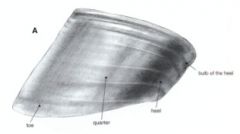
The toe, quarter, heel
|
|
|
What are the bars of the hoof?
|
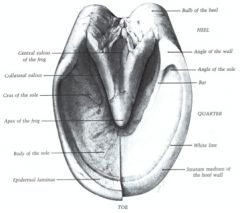
look at pic
|
|
|
What is the sole of the hoof?
Is it weight bearing? |
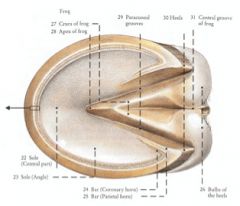
Ventral surface of the foot excluding frog
Should not bear weight |
|
|
What is the frog of the hoof? What % water is it. What are its parts?
|

50% water
Most elastic and resilient structure of foot Frog stay Central groove or sulcus Paracuneal grooves (collateral sulci) |
|
|
What is the white line of the equine hoof?
|
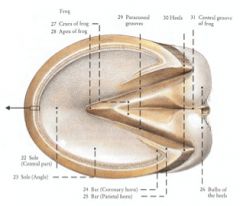
Junction between the sole and wall
|
|
|
At what level is the nail of the horse shoe inserted?
|
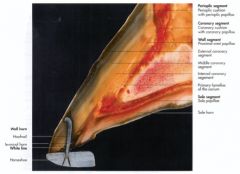
The level of the white line.
|
|
|
What is the digital cushion of the equine foot? What level of dermis is it? What types of connective tissue is it made of? What other structure does it overlay?
|
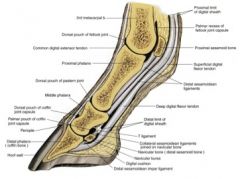
Hypodermis
Loose connective tissue – elastic fibers, fat, cartilage Reduces concussion to the foot Wedge-shaped mass Overlies the frog |
|
|
What is the frog stay?
|
The internal spine of the hoof.
|
|
|
What are the forces acting upon the distal phalanx?
|
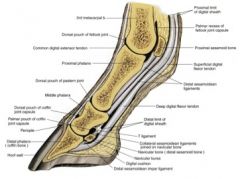
Pull of the deep digital flexor tendon
Weight of the horse Resistance of the ground Pull of the common digital extensor tendon Interdigitation of the laminar corium and stratum internum |
|
|
Which limbs are the shock absorbers in horses in jumps and at fast speeds?
|
the front limbs.
|
|
|
What % of weight do the front limbs of horses bear?
|
55-60%
|
|
|
What action shifts the center of gravity of a horse cranially?
|
Lowering the head
|
|
|
What action shifts the center of gravity of a horse caudally?
|
Raising the head
|
|
|
What would you expect to see when a horse has a lame forelimb?
|
The head rising when the painful forelimb hits the ground, down when the nonpainful one hits.
|
|
|
What would you expect to see when a horse has a lame hindlimb?
|
The head lowering when the painful hindlimb hits the ground, normal when the nonpainful one hits. This is why this is a bit harder to detect.
|
|

What are these arrows showing?
|

The pressures enacted on the horse limb. Illustrating the stay apparatus in this horse.
|
|
|
What is the passive stay apparatus of the horse?
|
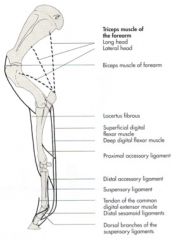
Enables horse to stand for long periods of time with minimal muscular effort
Active muscles tire quickly |
|
|
What prevents the shoulder joint from flexing in the stay apparatus of the horse?
|
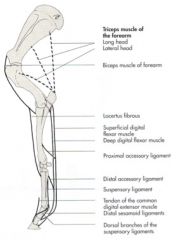
biceps brachii tendon
|
|
|
What prevents flexion of the elbow joint in the stay apparatus of the horse?
|
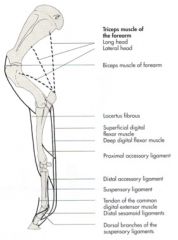
Flexion prevented by passive tension of carpal and digital flexors (SDF mainly) and by eccentrically placed collateral ligaments of the elbow joint
Minimal elements are needed to keep it in place. |
|
|
What prevents flexion of the carpus (or buckling forward) in the stay apparatus of the horse?
|
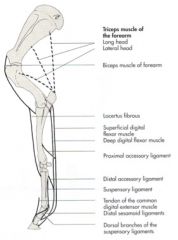
Flexion (buckling forward) prevented by upward pull of the lacertus fibrosus within the extensor carpi radialis tendon
|
|
|
What prevents overextension of the carpus in the stay apparatus of the horse?
|

Much is prevented by the square anatomy of the carpal bones, but also palmar carpal ligament
|
|
|
What prevents the overextension of the fetlock joint of the horse?
|
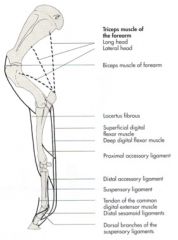
Overextension prevented by suspensory apparatus, SDF, DDF, check ligaments
|
|
|
What prevents the overextension of the pastern joint of the horse?
|
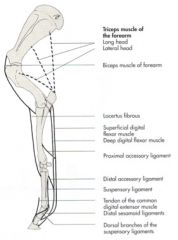
Overextension prevented by palmar ligaments, straight sesamoidean ligament, DDF
Buckling-over prevented by SDF |
|
|
What is the clinical signifigance of the distal interdigital ligament in the ruminant?
|

If you had to amputate the distal phalanx, you would want to be sure to not cut the distal interdigital ligament so that the toes don't splay.
|
|
|
Do ruminants have hoof walls, toes, bulbs, soles, white lines, bars, or frogs, as the horse hooves do?
|
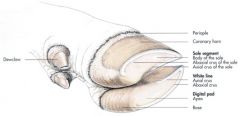
Yes, except no bars or frogs.
|
|
|
Do bovine have frog corium?
|
No there is no frog, so no frog corium.
|
|
|
Do bovine feet have secondary dermal or epidermal laminae in the stratum internum of the hoof wall?
|
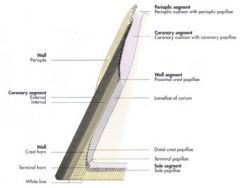
No.
|
|
|
What is the intersesamoidean (palmar) ligament? What does it fill the space between? What does it's palmar surface form?
|
Fibrocartilage structure in which the proximal sesamoids are largely embedded
Fills the space between and unites the proximal sesamoids Palmar surface forms a smooth groove for the deep digital flexor tendon (main function) |
|
|
What is the periople of the hoof?
|
Just below the coronet, the walls are covered for about an inch by a cornified, opaque 'periople' material. In the palmar/plantar part of the hoof, the periople is thicker and more rubbery over the heels, and it merges with frog material. Not all horses have the same amount of periople. Dry feet tend to lack this substance, which can be substituted with a hoof dressing.
|
|
|
How many primary and secondary laminae do the equine foot have?
|
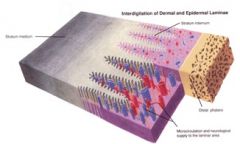
Primary laminae - 600
Secondary laminae - 100 |
|
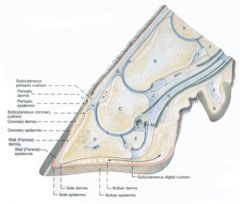
What can you name here?
|

here's the key
|

